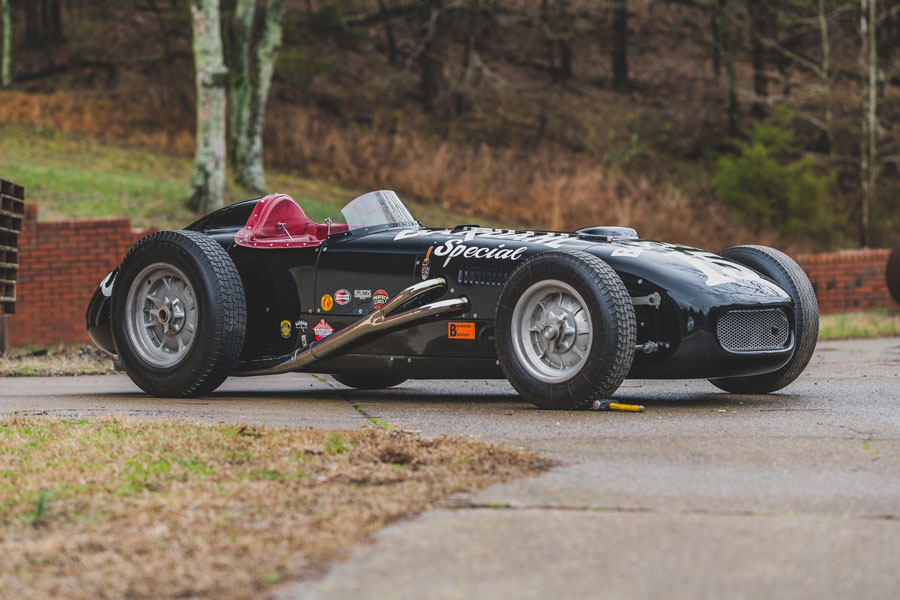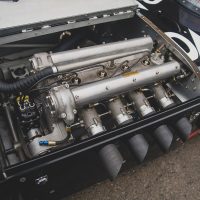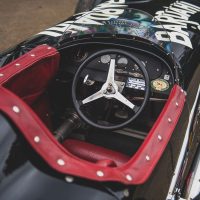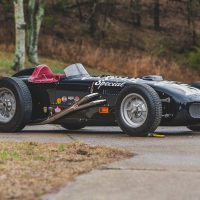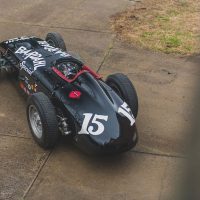- Offered from the Bill Akin Collection
- A significant example of a dominant design
- Four-time Indianapolis 500 competitor
- 1955 Indianapolis 500 3rd-place finisher
- Immaculately restored to historic No. 15 Bardahl livery
- Class winner at Pebble Beach and Amelia Island in 2010 and 2011, respectively
- Includes trophies and awards won by the car, along with period and recent photographs, period-correct inertia starter and battery cart, and a proper 17-inch Bell steering wheel
SCM Analysis
Detailing
| Vehicle: | 1953 Kurtis 500 B |
| Years Produced: | 1955–63 (Classic Indy Roadsters) |
| Number Produced: | About 50 Kurtis, 120 total various roadsters |
| Chassis Number Location: | Tag on frame in engine compartment |
| Engine Number Location: | Tag on left cam cover |
| Club Info: | Sportscar Vintage Racing Association |
| Website: | http://www.svra.com |
| Alternatives: | 1955–63 Indy Roadsters from various manufacturers |
| Investment Grade: | A |
This car, Lot 6151, sold for $550,000, including buyer’s premium, at the RM Sotheby’s Auburn Fall Auction in Auburn, IN, September 3–5, 2020.
I would propose that a collection of anything, be it automobiles, dolls or doilies, involves the indulgence of a fantasy about how things were, are or could be, and this requires a theme. It provides a focal point around which the collected pieces center and supplies the grand narrative that allows a group of possibly disparate items to tell an interesting story. This is why museums have highly educated professional curators.
In the U.S., probably the most common theme is Americana, the celebration of all the wonderful things, personality and circumstances that have combined to make the good old U.S. of A. what it is. The most prevalent Americana themes today surround the Greatest Generation, the period from the resilience and suffering of the Great Depression through the success and unfettered optimism of the Eisenhower years. If the subtext is automobilia, then the collection inevitably includes neon signs, jukeboxes, hot rods, and at least one or two Indianapolis race cars.
For those inclined towards nostalgia, the 1950s were a wonderful time. A muscular America stood astride the world, the envy of all. Nothing was impossible, with success available to anyone willing to work hard. Strength, attitude and ingenuity counted for as much as elite education, and shiny chrome was king. There was nothing effete or subtle about American racing cars and drivers of those days. They were loud, brutal and excitingly dangerous.
The classic Indianapolis era
If you are thinking about putting Indy cars into a collection, it is important to understand a bit more about them. Indianapolis racing has been around since 1909, but the period we are interested in really started in 1937, when the rules changed so that non-supercharged single-seat racers of 4.5 liters (or supercharged 3-liters) were the standard. This matched the European Grand Prix regulations (in keeping with Indy’s international aspirations), though with the war looming, few Europeans made the trip. But it was still an excellent fit for the dirt-track racers that were popular in the day; they just needed a bigger race engine for the 2.5-mile paved oval.
Offenhauser was standing ready to fill the need, and the “Offy” engine is an interesting aside. In 1912, Peugeot introduced a radical new racing engine for their Grand Prix cars. It used a barrel crankcase for strength, gear-driven double overhead camshafts, four valves per cylinder, and dry-sump oiling. It was a wonder of technology at the time. Peugeot sent several cars to Indianapolis in 1913, and one of them made it to Harry Miller’s shop in California for repairs. Miller recognized greatness, and more or less stole the design for his Miller racing cars, which became legendary. During the depression, Miller became Offenhauser (which in turn eventually became Meyer-Drake). Technological details evolved, but the original 1912 Peugeot concept was recognizable and effective all the way into the 1960s. It was the irreplaceable component, and from 1947 to 1964, every Indy 500 winner used an Offy engine.
There are three distinct subcategories for what we consider the classic Indy racers. In the beginning, the engine was centered in the chassis and the driver sat straddling the transmission and drive shaft. These are called the “upright” cars and ran from 1937 through about 1953.
In 1952, the Cummins diesel people wanted to publicize their engine and hired Frank Kurtis to build an Indy racer using one. It was so tall that Kurtis laid it on its side with the driveshaft running beside the driver. This had the effect of unbalancing the car to the left and moving the driver much lower in the seat. The Cummins Special wasn’t particularly successful, but the concept blew everybody away. If you always turn left, the unbalance is a huge advantage, and the low, wider shape was more slippery. The new look reminded people of California “roadster” hot rods, so the cars became known as “Indy Roadsters”; this is the second category.
Starting in 1958, in an attempt to get the center of mass even lower and the frontal area to a minimum, constructors started laying the Offy engine on its side. These are the third group and are called “Laydown Roadsters.” They dominated until the mid-engine revolution came from Europe and made all front-engine cars obsolete.
All three subcategories are glorious examples of uncompromised Americana and equally collectible. With brightly colored liveries, bold graphics and shining chrome, they are unabashedly commercial and in-your-face while celebrating an almost crude simplicity that hides the amazing sophistication of the details.
Drive if you dare
You may note that I have not spent much time talking about how much fun they are to drive. This is because they are not. These cars are hot, noisy, dirty, uncomfortable and terminally scary to drive at anything approaching their limits. The big 4-cylinder engines are hard-mounted to the chassis and shake like a crazed paint mixer at any speed. Your right elbow is inches away from the rear tire (also: the outside wall) and if something goes wrong, your chances of walking away are terrible. These cars were driven by men who survived World War II. Their mastery of fear against the likelihood of certain death was essential to their success. For us normal folks, not so much.
These cars can be and are occasionally taken out and run (cautiously). There used to be a few events per year for Indy roadsters (including a high-status one at Indianapolis itself) but they have faded away recently. In the end the value of these cars resides in anchoring fantasy collections of the imagined American experience. As such, there is always a market for them. Nostalgia will never become obsolete.
The value of Indy roadsters has held up well and even grown slowly over the 20 years that I’ve been watching. The prime determinants are racing success, famous drivers, make and attractive livery. There are more Kurtises out there, but A.J. Watson and Epperly cars are considered more valuable. If you are going to anchor a collection, you want shiny and bright. Restoration quality counts, particularly if you want to use it. The value range for good, complete runnable cars has been $350,000–$700,000 in the past few years, with most sales happening privately and few at auction.
The Bardahl Special was an excellent car from an impeccable source with the kind of big, bold graphics that collectors love, and it sold in the middle of the range. Its new owner will have a great display, a fun (if scary) ride should he choose to run it, and an excellent investment. Well bought. ♦
(Introductory description courtesy of RM Sotheby’s.)
